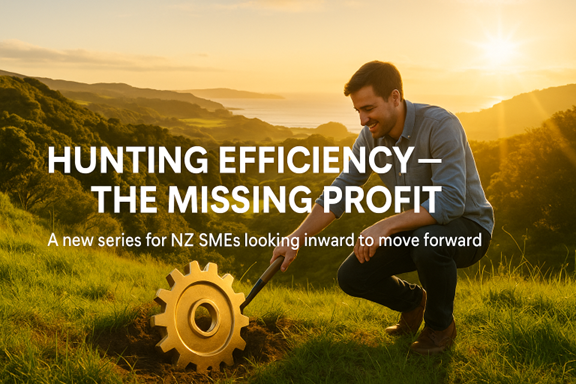27. Efficiency Is Sustainable Profit With a Smaller Footprint
A series about business efficiency, finding profit and how to get there
Introduction
For many small businesses, sustainability feels like a luxury. Something you think about when times are good, when the budget allows, or when your customers start asking.
But there’s a powerful truth most SME owners miss - sustainability and efficiency are two sides of the same coin.
Reducing waste, using fewer inputs, improving workflows, saving energy, minimising travel - these aren’t just good for the environment. They reduce your costs, speed up delivery and strengthen your brand.
Sustainability isn’t about doing more - it’s about doing smarter and in a time of high costs and high expectations, that’s not a “nice to have” - it’s a competitive advantage.
Actions to Be Taken
Here’s how to embed sustainability through an efficiency-first lens, without adding cost or complexity.
1. Start With a Resource Audit
Efficiency begins with awareness. Review -
Power and water bills
Printing, packaging and consumables
Delivery routes and vehicle use
Wastage in production, admin, or marketing
Where are you using more than you need? What do you regularly throw out, rework, or redo?
2. Cut Waste That Costs
Sustainability often begins with subtraction -
Digitise where possible (invoices, onboarding, contracts)
Reduce over-ordering stock or consumables
Streamline packaging - size, type, materials
Reuse offcuts, samples, or damaged goods internally or with partners
Waste is never just a sustainability issue. It’s a cashflow issue.
3. Choose Low-Impact Options That Improve Brand Value
Switching to compostable packaging, LED lighting, or local suppliers might not save you dollars immediately - but it builds a story.
Customers increasingly care how you operate, not just what you offer. And that can mean -
Higher retention
More referrals
Easier recruitment
Stronger partnerships
Make sustainability part of your value, not just your values.
4. Bring Your Team Into the Conversation
Efficiency is a team sport - so is sustainability. Ask -
What do we waste that frustrates you?
What could we reuse, repurpose, or remove?
What small changes would make your role more efficient?
The best green ideas often come from the floor, not the boardroom.
5. Measure Progress in Both Dollars and Impact
Track things like -
Reduction in printing or packaging
Kilometres saved through route changes or remote meetings
Cost savings from energy switches
Hours saved through process improvements
Celebrate those metrics internally and externally, they tell a story of leadership, not sacrifice.
Psychological Perspective
Many business owners fear that sustainability = expense. That it’s something for corporates or government-funded initiatives, not real-world, day-to-day business.
But the most powerful mindset shift is this - sustainability isn’t about sacrifice. It’s about smart stewardship.
When you frame eco-efficiency as part of how you protect your margin, your people and your future, it stops being optional and starts being obvious.
This also builds morale. People want to work for businesses that care. And they want to contribute to progress they can see.
HR Best Practice
Sustainability can become part of culture and HR is key to embedding it.
Best practices include -
Making sustainability part of onboarding, values and internal communications
Recognising team contributions to waste reduction or efficiency
Including sustainability metrics in role design (e.g. “reduce unnecessary travel” or “champion digital-first comms”)
Supporting initiatives like carpooling, work-from-home days, or volunteer days
Also sustainability can be a wellbeing initiative. A workplace that uses less, wastes less and cares more often feels calmer and more connected.
Red Flags to Watch For and Mitigate Against
Your footprint and your waste - might be too big if -
You routinely over-order or over-produce
You're printing, packaging, or delivering out of habit, not necessity
You have no visibility into energy or resource use
Staff are disengaged with sustainability conversations
You’re missing tenders or partnerships due to lack of ESG reporting or environmental commitments
These are signals that a shift toward lean, green operations isn’t just good ethics, it’s good strategy.
Narrative Story - Meet Niko and Ariana from Ōtaki
Niko and Ariana run a boutique skincare company. As demand grew, so did waste — packaging, freight, energy costs. They felt conflicted business was good, but their impact didn’t reflect their values.
They sat down with their team and mapped every area of waste - time, product, packaging, power. Within three months -
Switched to local suppliers for containers, reducing freight costs
Installed solar panels (with a government grant)
Reused packing materials from incoming orders
Changed courier routes to group deliveries more efficiently
They saved $1,800 in packaging and freight costs in the first quarter and saw a 12% increase in customer retention after they shared their changes online.
Ariana says - “We didn’t become perfect. But we became intentional. That made us proud and profitable.”
Golden Nugget
“Sustainability and efficiency share the same goal doing more with less, for longer - with purpose.”
If you’d like a confidential, free of charge, free of obligation conversation about your business, here’s how to get me.
📞 Phone +64 275 665 682
✉️ Email john.luxton@regenerationhq.co.nz
🌐 Contact Form www.regenerationhq.co.nz/contact
If you’d like to read more RegenerationHQ thinking on SME business and other things, go here – www.regenerationhq.co.nz/articlesoverview
🔹 RegenerationHQ Ltd - Business Problems Solved Sensibly.
Supporting NZ SME Owners to Exit Well, Lead Better and Build Business Value.

